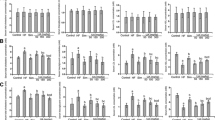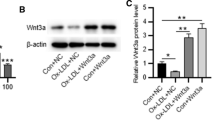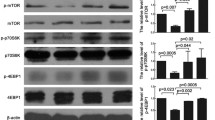Abstract
Endothelial cell injury is confirmed to be the initial step in the atherosclerosis (AS) process. Here, we tried to elucidate the role of liver kinase B1 (LKB1) and adenosine phosphate protein kinase (AMPK) in modulating vascular endothelial cells (VECs) in AS. High-fat feed (HFD)-induced AS rat models were prepared and treated with AMPK activator A-769662 alone or combined with chloroquine. An analysis of VEC injury, inflammation response, and autophagy followed it. The M1 linear ubiquitination of LKB1 was assessed by co-immunoprecipitation. The interaction between LKB1 and AMPK was analyzed. Primary aortic VECs were isolated and induced by LPS to verify the effects of LKB1 and AMPK on VEC injury in AS. Activation of AMPK reduced the VEC injury and inflammatory response of VECs and promoted autophagy caused by AS. LKB1 could regulate the activation of AMPK in AS. M1 linear ubiquitination enhanced LKB1 activity and increased AMPK activation to protect against VEC injury in AS, which was validated by in vitro experiments. Our current study highlighted that M1 linear ubiquitination of LKB1 may induce the activation of LKB1 to activate AMPK, which inhibited VEC injury in AS.






Similar content being viewed by others
Data availability
The datasets generated/analyzed during the current study are available upon request.
References
Herrington W, Lacey B, Sherliker P, Armitage J, Lewington S. Epidemiology of atherosclerosis and the potential to reduce the global burden of atherothrombotic disease. Circ Res. 2016;118(4):535–46. https://doi.org/10.1161/CIRCRESAHA.115.307611.
Rafieian-Kopaei M, Setorki M, Doudi M, Baradaran A, Nasri H. Atherosclerosis: process, indicators, risk factors, and new hopes. Int J Prev Med. 2014;5(8):927–46.
Gordts P, Esko JD. Corrigendum to “The heparan sulfate proteoglycan grip on hyperlipidemia and atherosclerosis” [Matrix Biol. 71-72 (2018) 262-282]. Matrix Biol. 2020;88:89. https://doi.org/10.1016/j.matbio.2020.02.002.
Raggi P, Genest J, Giles JT, Rayner KJ, Dwivedi G, Beanlands RS, et al. Role of inflammation in the pathogenesis of atherosclerosis and therapeutic interventions. Atherosclerosis. 2018;276:98–108. https://doi.org/10.1016/j.atherosclerosis.2018.07.014.
Weber C, Noels H. Atherosclerosis: current pathogenesis and therapeutic options. Nat Med. 2011;17(11):1410–22. https://doi.org/10.1038/nm.2538.
Lou X, Wang D, Gu Z, Li T, Ren L. Mechanism of microRNA regulating the progress of atherosclerosis in apoE-deficient mice. Bioengineered. 2021;12(2):10994–1006. https://doi.org/10.1080/21655979.2021.2004979.
Wang S, Li J, Chen A, Song H. Differentiated expression of long non-coding RNA-small nucleolar RNA host gene 8 in atherosclerosis and its molecular mechanism. Bioengineered. 2021;12(1):7167–76. https://doi.org/10.1080/21655979.2021.1979441.
Chang X, Lochner A, Wang HH, Wang S, Zhu H, Ren J, et al. Coronary microvascular injury in myocardial infarction: perception and knowledge for mitochondrial quality control. Theranostics. 2021;11(14):6766–85. https://doi.org/10.7150/thno.60143.
Wang J, Toan S, Zhou H. New insights into the role of mitochondria in cardiac microvascular ischemia/reperfusion injury. Angiogenesis. 2020;23(3):299–314. https://doi.org/10.1007/s10456-020-09720-2.
Li L, Chen Y, Shi C. Nintedanib ameliorates oxidized low-density lipoprotein-induced inflammation and cellular senescence in vascular endothelial cells. Bioengineered. 2022;13(3):6196–207. https://doi.org/10.1080/21655979.2022.2036913.
Yang Q, Xu J, Ma Q, Liu Z, Sudhahar V, Cao Y, et al. PRKAA1/AMPKalpha1-driven glycolysis in endothelial cells exposed to disturbed flow protects against atherosclerosis. Nat Commun. 2018;9(1):4667. https://doi.org/10.1038/s41467-018-07132-x.
Luo Y, Lu S, Ai Q, Zhou P, Qin M, Sun G, et al. SIRT1/AMPK and Akt/eNOS signaling pathways are involved in endothelial protection of total oral sides of Aralia elata (Miq). Seem against high-fat diet-induced atherosclerosis in ApoE-/- mice. Phytother Res. 2019;33(3):768–78. https://doi.org/10.1002/ptr.6269.
Ou H, Liu C, Feng W, Xiao X, Tang S, Mo Z. Role of AMPK in atherosclerosis via autophagy regulation. Sci China Life Sci. 2018;61(10):1212–21. https://doi.org/10.1007/s11427-017-9240-2.
Akhshi T, Trimble WS. A non-canonical Hedgehog pathway initiates ciliogenesis and autophagy. J Cell Biol. 2021;220(1):e202004179. https://doi.org/10.1083/jcb.202004179.
Zhao RX, Xu ZX. Targeting the LKB1 tumor suppressor. Curr Drug Targets. 2014;15(1):32–52. https://doi.org/10.2174/1389450114666140106095811.
Liu Z, Zhu H, Dai X, Wang C, Ding Y, Song P, et al. Macrophage liver kinase B1 inhibits foam cell formation and atherosclerosis. Circ Res. 2017;121(9):1047–57. https://doi.org/10.1161/CIRCRESAHA.117.311546.
Tao H, Yancey PG, Blakemore JL, Zhang Y, Ding L, Jerome WG, et al. Macrophage SR-BI modulates autophagy via VPS34 complex and PPARalpha transcription of Tfeb in atherosclerosis. J Clin Investig. 2021;131(7):e94229. https://doi.org/10.1172/JCI94229.
Li GH, Lin XL, Zhang H, Li S, He XL, Zhang K, et al. Ox-Lp(a) transiently induces HUVEC autophagy via an ROS-dependent PAPR-1-LKB1-AMPK-mTOR pathway. Atherosclerosis. 2015;243(1):223–35. https://doi.org/10.1016/j.atherosclerosis.2015.09.020.
Hasanvand A, Amini-Khoei H, Hadian MR, Abdollahi A, Tavangar SM, Dehpour AR, et al. Anti-inflammatory effect of AMPK signaling pathway in rat model of diabetic neuropathy. Inflammopharmacology. 2016;24(5):207–19.
Rymut SM, Lu B, Perez A, Corey DA, Lamb K, Cotton CU, et al. Acetyl-CoA carboxylase inhibition regulates microtubule dynamics and intracellular transport in cystic fibrosis epithelial cells. Am J Physiol Lung Cell Mol Physiol. 2019;316(6):L1081–93.
Lee HW, Rhee DK, Kim BO, Pyo S. Inhibitory effect of sinigrin on adipocyte differentiation in 3T3-L1 cells: involvement of AMPK and MAPK pathways. Biomed Pharmacother. 2018;102:670–80.
Fang K, Wu F, Chen G, Dong H, Li J, Zhao Y, et al. Diosgenin ameliorates palmitic acid-induced lipid accumulation via AMPK/ACC/CPT-1A and SREBP-1c/FAS signaling pathways in LO2 cells. BMC Complement Altern Med. 2019;19(1):255.
Hasei S, Yamamotoya T, Nakatsu Y, Ohata Y, Itoga S, Nonaka Y, et al. Carnosic acid and carnosol activate AMPK, suppress expressions of gluconeogenic and lipogenic genes, and inhibit proliferation of HepG2 cells. Int J Mol Sci. 2021;22(8):4040.
Chang WC, Wu JS, Chen CW, Kuo PL, Chien HM, Wang YT, et al. Protective effect of vanillic acid against hyperinsulinemia, hyperglycemia and hyperlipidemia via alleviating hepatic insulin resistance and inflammation in high-fat diet (HFD)-fed rats. Nutrients. 2015;7(12):9946–59.
Gao M, Xin G, Qiu X, Wang Y, Liu G. Establishment of a rat model with diet-induced coronary atherosclerosis. J Biomed Res. 2016;31(1):47–55. https://doi.org/10.7555/JBR.31.20160020.
Du F, Huang H, Cao Y, Ran Y, Wu Q, Chen B. Notoginsenoside R1 protects against high glucose-induced cell injury through AMPK/Nrf2 and downstream HO-1 signaling. Front Cell Dev Biol. 2021;9:791643. https://doi.org/10.3389/fcell.2021.791643.
Zhang M, Zhu H, Ding Y, Liu Z, Cai Z, Zou MH. AMP-activated protein kinase alpha1 promotes atherogenesis by increasing monocyte-to-macrophage differentiation. J Biol Chem. 2017;292(19):7888–903. https://doi.org/10.1074/jbc.M117.779447.
Chen F, Li J, Zheng T, Chen T, Yuan Z. KLF7 alleviates atherosclerotic lesions and inhibits glucose metabolic reprogramming in macrophages by regulating HDAC4/miR-148b-3p/NCOR1. Gerontology. 2022;68(11):1291–310. https://doi.org/10.1159/000524029.
Zhou H, Shi C, Hu S, Zhu H, Ren J, Chen Y. BI1 is associated with microvascular protection in cardiac ischemia-reperfusion injury via repressing Syk-Nox2-Drp1-mitochondrial fission pathways. Angiogenesis. 2018;21(3):599–615. https://doi.org/10.1007/s10456-018-9611-z.
Frye CA, Patrick CW Jr. Isolation and culture of rat microvascular endothelial cells. In Vitro Cell Dev Biol Anim. 2002;38(4):208–12. https://doi.org/10.1290/1071-2690(2002)038%3c0208:IACORM%3e2.0.CO;2.
Lu Z, Li Y, Brinson CW, Lopes-Virella MF, Huang Y. Cooperative stimulation of atherogenesis by lipopolysaccharide and palmitic acid-rich high-fat diet in low-density lipoprotein receptor-deficient mice. Atherosclerosis. 2017;265:231–41. https://doi.org/10.1016/j.atherosclerosis.2017.09.008.
Shalem O, Sanjana NE, Hartenian E, Shi X, Scott DA, Mikkelson T, et al. Genome-scale CRISPR-Cas9 knockout screening in human cells. Science. 2014;343(6166):84–7. https://doi.org/10.1126/science.1247005.
Hinkelbein J, Bohm L, Braunecker S, Adler C, De Robertis E, Cirillo F. Decreased tissue COX5B expression and mitochondrial dysfunction during sepsis-induced kidney injury in rats. Oxid Med Cell Longev. 2017;2017:8498510. https://doi.org/10.1155/2017/8498510.
Tan Y, Mui D, Toan S, Zhu P, Li R, Zhou H. SERCA overexpression improves mitochondrial quality control and attenuates cardiac microvascular ischemia-reperfusion injury. Mol Ther Nucleic Acids. 2020;22:696–707. https://doi.org/10.1016/j.omtn.2020.09.013.
Gassen NC, Niemeyer D, Muth D, Corman VM, Martinelli S, Gassen A, et al. SKP2 attenuates autophagy through Beclin1-ubiquitination, and its inhibition reduces MERS-Coronavirus infection. Nat Commun. 2019;10(1):5770. https://doi.org/10.1038/s41467-019-13659-4.
Mi L, Zhang Y, Xu Y, Zheng X, Zhang X, Wang Z, et al. HMGB1/RAGE pro-inflammatory axis promotes vascular endothelial cell apoptosis in limb ischemia/reperfusion injury. Biomed Pharmacother. 2019;116:109005. https://doi.org/10.1016/j.biopha.2019.109005.
Qi T, Jing R, Ma B, Hu C, Wen C, Shao Y, et al. The E3 ligase RNF157 inhibits lens epithelial cell apoptosis by negatively regulating p53 in age-related cataracts. Investig Ophthalmol Vis Sci. 2022;63(4):11. https://doi.org/10.1167/iovs.63.4.11.
Yang S, Wang J. Estrogen activates AMP-activated protein kinase in human endothelial cells via ERbeta/Ca(2+)/calmodulin-dependent protein kinase kinase beta pathway. Cell Biochem Biophys. 2015;72(3):701–7. https://doi.org/10.1007/s12013-015-0521-z.
Lu W, Su L, Yu Z, Zhang S, Miao J. The new role of CD163 in the differentiation of bone marrow stromal cells into vascular endothelial-like cells. Stem Cells Int. 2016;2016:2539781. https://doi.org/10.1155/2016/2539781.
Ouimet M, Franklin V, Mak E, Liao X, Tabas I, Marcel YL. Autophagy regulates cholesterol efflux from macrophage foam cells via lysosomal acid lipase. Cell Metab. 2011;13(6):655–67. https://doi.org/10.1016/j.cmet.2011.03.023.
Singh R, Kaushik S, Wang Y, Xiang Y, Novak I, Komatsu M, et al. Autophagy regulates lipid metabolism. Nature. 2009;458(7242):1131–5. https://doi.org/10.1038/nature07976.
Khawar MB, Gao H, Li W. Autophagy and lipid metabolism. Adv Exp Med Biol. 2019;1206:359–74. https://doi.org/10.1007/978-981-15-0602-4_17.
Saito T, Kuma A, Sugiura Y, Ichimura Y, Obata M, Kitamura H, et al. Autophagy regulates lipid metabolism through selective turnover of NCoR1. Nat Commun. 2019;10(1):1567. https://doi.org/10.1038/s41467-019-08829-3.
Hawley SA, Boudeau J, Reid JL, Mustard KJ, Udd L, Makela TP, et al. Complexes between the LKB1 tumor suppressor, STRAD alpha/beta, and MO25 alpha/beta are upstream kinases in the AMP-activated protein kinase cascade. J Biol. 2003;2(4):28. https://doi.org/10.1186/1475-4924-2-28.
Yan Y, Zhou XE, Xu HE, Melcher K. Structure and physiological regulation of AMPK. Int J Mol Sci. 2018;19(11):3534. https://doi.org/10.3390/ijms19113534.
Cacicedo JM, Gauthier MS, Lebrasseur NK, Jasuja R, Ruderman NB, Ido Y. Acute exercise activates AMPK and eNOS in the mouse aorta. Am J Physiol Heart Circ Physiol. 2011;301(4):H1255–65. https://doi.org/10.1152/ajpheart.01279.2010.
Majd S, Power JHT, Chataway TK, Grantham HJM. A comparison of LKB1/AMPK/mTOR metabolic axis response to global ischemia in brain, heart, liver, and kidney in a rat model of cardiac arrest. BMC Cell Biol. 2018;19(1):7. https://doi.org/10.1186/s12860-018-0159-y.
Kullmann L, Krahn MP. Controlling the master-upstream regulation of the tumor suppressor LKB1. Oncogene. 2018;37(23):3045–57. https://doi.org/10.1038/s41388-018-0145-z.
Lee SW, Lin HK. A new mechanism for LKB1 activation. Mol Cell Oncol. 2018;5(3):e1035691. https://doi.org/10.1080/23723556.2015.1035691.
Zheng Y, Tao Y, Zhan X, Wu Q. Nuclear receptor 4A1 (NR4A1) silencing protects hepatocyte against hypoxia-reperfusion injury in vitro by activating liver kinase B1 (LKB1)/AMP-activated protein kinase (AMPK) signaling. Bioengineered. 2022;13(4):8349–59. https://doi.org/10.1080/21655979.2022.2053804.
LeBlond ND, Ghorbani P, O’Dwyer C, Ambursley N, Nunes JRC, Smith TKT, et al. Myeloid deletion and therapeutic activation of AMPK do not alter atherosclerosis in male or female mice. J Lipid Res. 2020;61(12):1697–706. https://doi.org/10.1194/jlr.RA120001040.
Ma A, Wang J, Yang L, An Y, Zhu H. AMPK activation enhances the anti-atherogenic effects of high density lipoproteins in apoE(-/-) mice. J Lipid Res. 2017;58(8):1536–47. https://doi.org/10.1194/jlr.M073270.
Wang J, Ma A, Zhao M, Zhu H. AMPK activation reduces the number of atheromata macrophages in ApoE deficient mice. Atherosclerosis. 2017;258:97–107. https://doi.org/10.1016/j.atherosclerosis.2017.01.036.
LeBlond ND, Nunes JRC, Smith TKT, O’Dwyer C, Robichaud S, Gadde S, et al. Foam cell induction activates AMPK but uncouples its regulation of autophagy and lysosomal homeostasis. Int J Mol Sci. 2020;21(23):9033. https://doi.org/10.3390/ijms21239033.
Motoshima H, Goldstein BJ, Igata M, Araki E. AMPK, and cell proliferation–AMPK as a therapeutic target for atherosclerosis and cancer. J Physiol. 2006;574(Pt 1):63–71. https://doi.org/10.1113/jphysiol.2006.108324.
Abedimanesh N, Motlagh B, Abedimanesh S, Bathaie SZ, Separham A, Ostadrahimi A. Effects of crocin and saffron aqueous extract on gene expression of SIRT1, AMPK, LOX1, NF-kappaB, and MCP-1 in patients with coronary artery disease: A randomized placebo-controlled clinical trial. Phytother Res. 2020;34(5):1114–22. https://doi.org/10.1002/ptr.6580.
Acknowledgements
Not applicable.
Funding
This study was funded by Basic research in Bao'an District, Shenzhen in 2021 (medical and health) (No. 2021JD301), Scientific Research Project of Guangdong Administration of Traditional Chinese Medicine (No. 20222197), and The research Project of Luohu District soft science (No. LX202202041).
Author information
Authors and Affiliations
Contributions
HH: conceptualization, validation, writing—original draft, and writing—review and editing; ZH: investigation, visualization, and writing—original draft; WL: Formal analysis, software, and writing—original draft; TZ: methodology, data curation, and writing—original draft; XS: conceptualization, resources, supervision, and writing—review and editing; HY: conceptualization, project administration, and writing—review and editing.
Corresponding authors
Ethics declarations
Conflict of interest
The authors declare that they have no known competing financial interests or personal relationships that could have appeared to influence the work reported in this paper.
Ethics approval
The animal study was conducted following the protocol approved by our hospital (Approved No. 2022-0415) and following the National Institutes of Health guidelines.
Additional information
Publisher's Note
Springer Nature remains neutral with regard to jurisdictional claims in published maps and institutional affiliations.
Supplementary Information
Below is the link to the electronic supplementary material.
Rights and permissions
Springer Nature or its licensor (e.g. a society or other partner) holds exclusive rights to this article under a publishing agreement with the author(s) or other rightsholder(s); author self-archiving of the accepted manuscript version of this article is solely governed by the terms of such publishing agreement and applicable law.
About this article
Cite this article
Huangfu, H., Huang, Z., Liao, W. et al. M1 linear ubiquitination of LKB1 inhibits vascular endothelial cell injury in atherosclerosis through activation of AMPK. Human Cell 36, 1901–1914 (2023). https://doi.org/10.1007/s13577-023-00950-2
Received:
Accepted:
Published:
Issue Date:
DOI: https://doi.org/10.1007/s13577-023-00950-2




